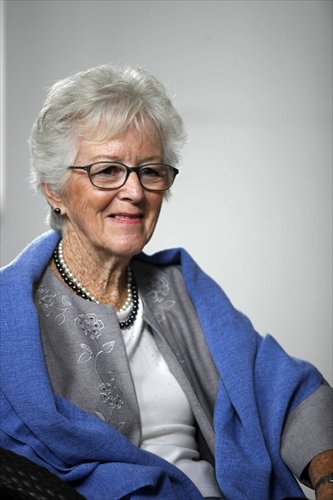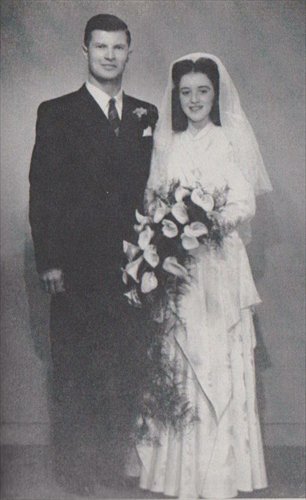The homecoming
When 84-year-old Betty Grebenschikoff was walking along the Bund on a sunny Monday afternoon, she couldn't help wondering why people were taking wedding photos on the Garden Bridge, just a few blocks away from her old home in Hongkou district where she lived in the 1940s.
"Is it a special occasion for newlyweds?" she asked the staff from the Shanghai Jewish Refugees Museum. When she heard that the Garden Bridge is now a popular spot for couples to have their wedding photos taken, the gray-haired lady smiled, "Everything is different now."
Grebenschikoff, who now lives in the US, was in town this week with her daughter Irene Grebenschikoff to talk about her life as a Jewish refugee in the city.

Betty Grebenschikoff
Trip to Shanghai
Born in Berlin in 1929, the young Grebenschikoff, née Kohn, never imagined she would spend a decade in the Far East.
"Smoldering anti-Semitism in Central Europe finally burst into full bloom, with the encouragement and active participation of the Hitler regime. Restriction and penalties levied at Jews, so-called Aryanization of Jewish businesses and enterprises in Germany became more and more widespread, culminating with what came to be known as Crystal Night, in November of 1938," Grebenschikoff wrote in her autobiography Once My Name was Sara.
Though her relatives stayed positive about the future of local Jews in Germany, Grebenschikoff's father started to worry about the safety of his family. "My father tried every possibility to get us out of the country, but not until May in 1939 did we finally get tickets on the Japanese cruise ship Kashima Maru," she told the Global Times.
When the six members of the Kohn family got onboard, including her parents, her elder sister, her uncle and aunt, Grebenschikoff's father still had a summons from the Gestapo ordering him to appear at their headquarters in Berlin two days later.
"We were very lucky to get the chance to leave Germany in 1939," Grebenschikoff said. "When the war finished, only my family and two other cousins survived. All the other relatives were murdered by the Nazis."
The Kashima Maru left Naples, Italy, on May 21 and arrived in Shanghai, the only port that admitted European Jews without passports or visas, four weeks later.

Betty Grebenschikoff decided to donate her wedding gown to the Shanghai Jewish Refugees Museum. Photos: Cai Xianmin/GT and courtesy of Shanghai Jewish Refugees Museum
Life in Shanghai
Grebenschikoff was just 9 years old when she set foot in the busy port of Shanghai as refugee. "June was really hot in Shanghai," she said. "All I can remember was the heat, the crowd and the noise."
With the help of Jewish organizations in Shanghai, the Kohn family managed to get a room in what is now 51 Zhoushan Road in Hongkou district. Grebenschikoff and her 11-year-old sister were later enrolled at the Shanghai Jewish Association's school.
Like many refugees, the Kohn sisters believed they would return to Europe soon after they arrived.
"We did not know any English back in 1939, but the school here in Shanghai taught us everything in English," Grebenschikoff recalled.
Grebenschikoff and her sister adapted to life in Shanghai quickly and made friends with the Shanghainese children in the lane. "They were not surprised by our foreign faces and no one ever asked why we were here," Grebenschikoff recalled, "the neighbors were very friendly."
Still, life was tough in the 1940s. Grebenschikoff had to share a small room with her sister and her parents in a shikumen house. Sixteen people shared a bathroom and four to five households shared a kitchen.
"There was a hospital on Changyang Road with German doctors," Grebenschikoff said. "However, it was always short of proper medications."
The Hongkew (now Hongkou) ghetto was referred to as "Little Vienna" in the 1940s. There were grocery stores, restaurants and coffee shops opened by Jews. "We had our theater shows, newspapers, radio programs and other entertaining activities to make life more cheerful here," Grebenschikoff said.
Romance in Shanghai
This is Grebenschikoff's fourth trip back to Shanghai after she left China in 1950. "In my last trip to the country, I also went to Xi'an in Shaanxi Province and the capital, Beijing," she said, "but this time I want it to be just Shanghai."
A relaxing walk on the Bund, a morning jog in People's Park, afternoon tea at the Peace Hotel and a fine dinner at the Park Hotel was all she planned to do in the city, where she met the love of her life, Oleg Grebenschikoff. It was the summer of 1948. Grebenschikoff left her air conditioned office in the Glenline Building, where she worked as a secretary for the US Navy Supply Department, and went to a local swimming pool for a cool dip.
The young Russian lifeguard volunteered to be her coach on duty. "He asked me if I was interested in learning how to dive," Grebenschikoff smiled.
She and her future husband had their first date at the Peace Hotel. They were engaged two weeks after they met and married within two months.
Grebenschikoff's Russian mother-in-law got her a beautiful handmade satin wedding gown from the high-end tailor shop Madame Greenhouse on Nanjing Road West. "Two of my daughters wore the dress on their wedding days," she said, "It was a classic and a great memory."
Grebenschikoff decided to donate her wedding gown to the Shanghai Jewish Refugees Museum during her recent trip to Shanghai.
"When I came to Shanghai with my husband in 2000, we were very surprised to see our wedding photo hanging on the wall of the museum," Grebenschikoff said.
She told the staff that she was the bride in the photo and everyone was delighted to be able to meet her in person.
"The wedding gown belongs to Shanghai," Grebenschikoff said. "Her daughter is coming back home."